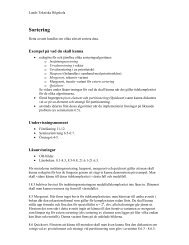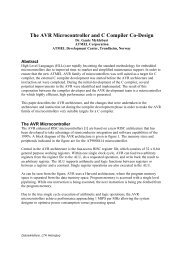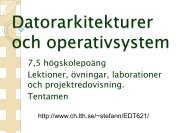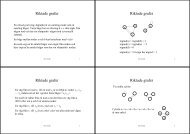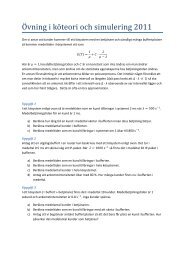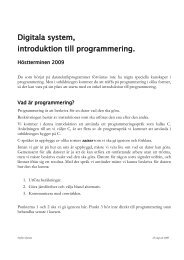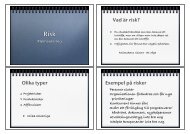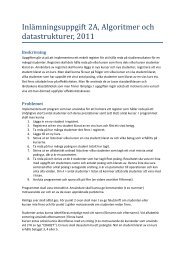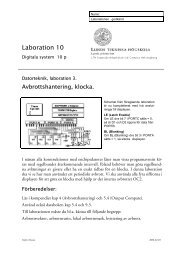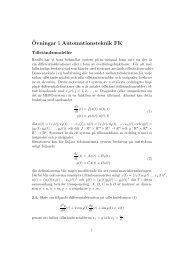DS18B20-PAR 1-Wire Parasite-Power Digital Thermometer
DS18B20-PAR 1-Wire Parasite-Power Digital Thermometer
DS18B20-PAR 1-Wire Parasite-Power Digital Thermometer
- No tags were found...
You also want an ePaper? Increase the reach of your titles
YUMPU automatically turns print PDFs into web optimized ePapers that Google loves.
FEATURES Unique 1-<strong>Wire</strong> ® interface requires only oneport pin for communication Derives power from data line (“parasitepower”)—does not need a local power supply Multi-drop capability simplifies distributedtemperature sensing applications Requires no external components 0.5C accuracy from –10°C to +85°C Measures temperatures from –55°C to+100°C (–67°F to +212°F) <strong>Thermometer</strong> resolution is user-selectablefrom 9 to 12 bits Converts temperature to 12-bit digital word in750 ms (max.) User–definable non-volatile temperaturealarm settings Alarm search command identifies andaddresses devices whose temperature isoutside of programmed limits (temperaturealarm condition)www.maxim-ic.comSoftware compatible with the DS1822-<strong>PAR</strong>Ideal for use in remote sensing applications(e.g., temperature probes) that do not have alocal power sourcePIN ASSIGNMENTPIN DESCRIPTIONGNDDQNC<strong>DS18B20</strong>-<strong>PAR</strong>1-<strong>Wire</strong> <strong>Parasite</strong>-<strong>Power</strong><strong>Digital</strong> <strong>Thermometer</strong>DALLAS18B20P11TO-92(<strong>DS18B20</strong>-<strong>PAR</strong>)- Ground- Data In/Out- No Connect2 3GNDDQNC2 3(BOTTOM VIEW)DESCRIPTIONThe <strong>DS18B20</strong>-<strong>PAR</strong> digital thermometer provides 9 to 12–bit centigrade temperature measurements andhas an alarm function with nonvolatile user-programmable upper and lower trigger points. The<strong>DS18B20</strong>-<strong>PAR</strong> does not need an external power supply because it derives power directly from the dataline (“parasite power”). The <strong>DS18B20</strong>-<strong>PAR</strong> communicates over a 1-<strong>Wire</strong> bus, which by definitionrequires only one data line (and ground) for communication with a central microprocessor. It has anoperating temperature range of –55°C to +100°C and is accurate to 0.5C over a range of –10°C to+85°C.Each <strong>DS18B20</strong>-<strong>PAR</strong> has a unique 64-bit identification code, which allows multiple <strong>DS18B20</strong>-<strong>PAR</strong>s tofunction on the same 1–wire bus; thus, it is simple to use one microprocessor to control many <strong>DS18B20</strong>-<strong>PAR</strong>s distributed over a large area. Applications that can benefit from this feature include HVACenvironmental controls, temperature monitoring systems inside buildings, equipment or machinery, andprocess monitoring and control systems.1-<strong>Wire</strong> is a registered trademark of Dallas Semiconductor.1 of 19 111903
<strong>DS18B20</strong>-<strong>PAR</strong><strong>PAR</strong>ASITE POWERThe <strong>DS18B20</strong>-<strong>PAR</strong>’s parasite power circuit allows the <strong>DS18B20</strong>-<strong>PAR</strong> to operate without a local externalpower supply. This ability is especially useful for applications that require remote temperature sensing orthat are very space constrained. Figure 1 shows the <strong>DS18B20</strong>-<strong>PAR</strong>’s parasite-power control circuitry,which “steals” power from the 1-<strong>Wire</strong> bus via the DQ pin when the bus is high. The stolen chargepowers the <strong>DS18B20</strong>-<strong>PAR</strong> while the bus is high, and some of the charge is stored on the parasite powercapacitor (C PP ) to provide power when the bus is low.The 1-<strong>Wire</strong> bus and C PP can provide sufficient parasite power to the <strong>DS18B20</strong>-<strong>PAR</strong> for most operationsas long as the specified timing and voltage requirements are met (refer to the DC ELECTRICALCHARACTERISTICS and the AC ELECTRICAL CHARACTERISTICS sections of this data sheet).However, when the <strong>DS18B20</strong>-<strong>PAR</strong> is performing temperature conversions or copying data from thescratchpad memory to EEPROM, the operating current can be as high as 1.5 mA. This current can causean unacceptable voltage drop across the weak 1-<strong>Wire</strong> pullup resistor and is more current than can besupplied by C PP . To assure that the <strong>DS18B20</strong>-<strong>PAR</strong> has sufficient supply current, it is necessary toprovide a strong pullup on the 1-<strong>Wire</strong> bus whenever temperature conversions are taking place or data isbeing copied from the scratchpad to EEPROM. This can be accomplished by using a MOSFET to pullthe bus directly to the rail as shown in Figure 2. The 1-<strong>Wire</strong> bus must be switched to the strong pullupwithin 10 s (max) after a Convert T [44h] or Copy Scratchpad [48h] command is issued, and the busmust be held high by the pullup for the duration of the conversion (t conv ) or data transfer (t wr = 10 ms).No other activity can take place on the 1-<strong>Wire</strong> bus while the pullup is enabled.SUPPLYING THE <strong>DS18B20</strong>-<strong>PAR</strong> DURING TEMPERATURE CONVERSIONSFigure 2V PU<strong>DS18B20</strong>-<strong>PAR</strong>MicroprocessorV PU4.7K1-<strong>Wire</strong> BusGNDDQTo Other1-<strong>Wire</strong> DevicesOPERATION – MEASURING TEMPERATUREThe core functionality of the <strong>DS18B20</strong>-<strong>PAR</strong> is its direct-to-digital temperature sensor. The resolution ofthe temperature sensor is user-configurable to 9, 10, 11, or 12 bits, which corresponds to increments of0.5C, 0.25C, 0.125C, and 0.0625C, respectively. The default resolution at power-up is 12-bit.The <strong>DS18B20</strong>-<strong>PAR</strong> powers-up in a low-power idle state; to initiate a temperature measurement and A-to-D conversion, the master must issue a Convert T [44h] command. Following the conversion, theresulting thermal data is stored in the 2-byte temperature register in the scratchpad memory and the<strong>DS18B20</strong>-<strong>PAR</strong> returns to its idle state. The <strong>DS18B20</strong>-<strong>PAR</strong> output data is calibrated in degreescentigrade; for Fahrenheit applications, a lookup table or conversion routine must be used. Thetemperature data is stored as a 16-bit sign-extended two’s complement number in the temperature register(see Figure 3). The sign bits (S) indicate if the temperature is positive or negative: for positive numbers S= 0 and for negative numbers S = 1. If the <strong>DS18B20</strong>-<strong>PAR</strong> is configured for 12-bit resolution, all bits inthe temperature register will contain valid data. For 11-bit resolution, bit 0 is undefined. For 10-bit3 of 19
<strong>DS18B20</strong>-<strong>PAR</strong>resolution, bits 1 and 0 are undefined, and for 9-bit resolution bits 2, 1 and 0 are undefined. Table 2 givesexamples of digital output data and the corresponding temperature reading for 12-bit resolutionconversions.TEMPERATURE REGISTER FORMAT Figure 3bit 7 bit 6 bit 5 bit 4 bit 3 bit 2 bit 1 bit 0LS Byte 2 3 2 2 2 1 2 0 2 -1 2 -2 2 -3 2 -4bit 15 bit 14 bit 13 bit 12 bit 11 bit 10 bit 9 bit 8MS Byte S S S S S 2 6 2 5 2 4TEMPERATURE/DATA RELATIONSHIP Table 2TEMPERATUREDIGITAL OUTPUT(Binary)DIGITAL OUTPUT(Hex)+85°C* 0000 0101 0101 0000 0550h+25.0625°C 0000 0001 1001 0001 0191h+10.125°C 0000 0000 1010 0010 00A2h+0.5°C 0000 0000 0000 1000 0008h0°C 0000 0000 0000 0000 0000h-0.5°C 1111 1111 1111 1000 FFF8h-10.125°C 1111 1111 0101 1110 FF5Eh-25.0625°C 1111 1110 0110 1111 FE6Fh-55°C 1111 1100 1001 0000 FC90h*The power-on reset value of the temperature register is +85°COPERATION – ALARM SIGNALINGAfter the <strong>DS18B20</strong>-<strong>PAR</strong> performs a temperature conversion, the temperature value is compared to theuser-defined two’s complement alarm trigger values stored in the 1-byte T H and T L registers (see Figure4). The sign bit (S) indicates if the value is positive or negative: for positive numbers S = 0 and fornegative numbers S = 1. The T H and T L registers are nonvolatile (EEPROM) so they will retain datawhen the device is powered down. T H and T L can be accessed through bytes 2 and 3 of the scratchpad asexplained in the MEMORY section of this datasheet.T H AND T L REGISTER FORMAT Figure 4bit 7 bit 6 bit 5 bit 4 bit 3 bit 2 bit 1 bit 0S 2 6 2 5 2 5 2 5 2 2 2 1 2 0Only bits 11 through 4 of the temperature register are used in the T H and T L comparison since T H and T Lare 8-bit registers. If the result of a temperature measurement is higher than T H or lower than T L , analarm condition exists and an alarm flag is set inside the <strong>DS18B20</strong>-<strong>PAR</strong>. This flag is updated after everytemperature measurement; therefore, if the alarm condition goes away, the flag will be turned off after thenext temperature conversion.4 of 19
<strong>DS18B20</strong>-<strong>PAR</strong>The master device can check the alarm flag status of all DS <strong>DS18B20</strong>-<strong>PAR</strong>s on the bus by issuing anAlarm Search [ECh] command. Any <strong>DS18B20</strong>-<strong>PAR</strong>s with a set alarm flag will respond to the command,so the master can determine exactly which <strong>DS18B20</strong>-<strong>PAR</strong>s have experienced an alarm condition. If analarm condition exists and the T H or T L settings have changed, another temperature conversion should bedone to validate the alarm condition.64-BIT LASERED ROM CODEEach <strong>DS18B20</strong>-<strong>PAR</strong> contains a unique 64–bit code (see Figure 5) stored in ROM. The least significant 8bits of the ROM code contain the <strong>DS18B20</strong>-<strong>PAR</strong>’s 1–wire family code: 28h. The next 48 bits contain aunique serial number. The most significant 8 bits contain a cyclic redundancy check (CRC) byte that iscalculated from the first 56 bits of the ROM code. A detailed explanation of the CRC bits is provided inthe CRC GENERATION section. The 64–bit ROM code and associated ROM function control logicallow the <strong>DS18B20</strong>-<strong>PAR</strong> to operate as a 1–wire device using the protocol detailed in the 1-WIRE BUSSYSTEM section of this datasheet.64-BIT LASERED ROM CODE Figure 5MSB8-BIT CRC 48-BIT SERIAL NUMBER 8-BIT FAMILY CODE (28h)LSB MSBLSB MSBLSBMEMORYThe <strong>DS18B20</strong>-<strong>PAR</strong>’s memory is organized as shown in Figure 6. The memory consists of an SRAMscratchpad with nonvolatile EEPROM storage for the high and low alarm trigger registers (T H and T L )and configuration register. Note that if the <strong>DS18B20</strong>-<strong>PAR</strong> alarm function is not used, the T H and T Lregisters can serve as general-purpose memory. All memory commands are described in detail in the<strong>DS18B20</strong>-<strong>PAR</strong> FUNCTION COMMANDS section.Byte 0 and byte 1 of the scratchpad contain the LSB and the MSB of the temperature register,respectively. These bytes are read-only. Bytes 2 and 3 provide access to T H and T L registers. Byte 4contains the configuration register data, which is explained in detail in the CONFIGURATIONREGISTER section of this datasheet. Bytes 5, 6 and 7 are reserved for internal use by the device andcannot be overwritten; these bytes will return all 1s when read.Byte 8 of the scratchpad is read-only and contains the cyclic redundancy check (CRC) code for bytes 0through 7 of the scratchpad. The <strong>DS18B20</strong>-<strong>PAR</strong> generates this CRC using the method described in theCRC GENERATION section.Data is written to bytes 2, 3, and 4 of the scratchpad using the Write Scratchpad [4Eh] command, and thedata must be transmitted to the <strong>DS18B20</strong>-<strong>PAR</strong> starting with the least significant bit of byte 2. To verifydata integrity, the scratchpad can be read (using the Read Scratchpad [BEh] command) after the data iswritten. When reading the scratchpad, data is transferred over the 1-<strong>Wire</strong> bus starting with the leastsignificant bit of byte 0. To transfer the T H , T L and configuration data from the scratchpad to EEPROM,the master must issue the Copy Scratchpad [48h] command.Data in the EEPROM registers is retained when the device is powered down; at power-up the EEPROMdata is reloaded into the corresponding scratchpad locations. Data can also be reloaded from EEPROMto the scratchpad at any time using the Recall E 2 [B8h] command. The master can issue “read time slots”(see the 1-WIRE BUS SYSTEM section) following the Recall E 2 command and the <strong>DS18B20</strong>-<strong>PAR</strong> willindicate the status of the recall by transmitting 0 while the recall is in progress and 1 when the recall isdone.5 of 19
<strong>DS18B20</strong>-<strong>PAR</strong> MEMORY MAP Figure 6<strong>DS18B20</strong>-<strong>PAR</strong>SCRATCHPAD (<strong>Power</strong>-up State)byte 0 Temperature LSB (50h)(85°C)byte 1 Temperature MSB (05h) EEPROMbyte 2 T H Register or User Byte 1* T H Register or User Byte 1byte 3 T L Register or User Byte 2* T L Register or User Byte 2byte 4 Configuration Register* Configuration Registerbyte 5byte 6byte 7byte 8Reserved (FFh)Reserved (0Ch)Reserved (10h)CRC**<strong>Power</strong>-up state depends on value(s) storedin EEPROMCONFIGURATION REGISTERByte 4 of the scratchpad memory contains the configuration register, which is organized as illustrated inFigure 7. The user can set the conversion resolution of the <strong>DS18B20</strong>-<strong>PAR</strong> using the R0 and R1 bits inthis register as shown in Table 3. The power-up default of these bits is R0 = 1 and R1 = 1 (12-bitresolution). Note that there is a direct tradeoff between resolution and conversion time. Bit 7 and bits 0-4in the configuration register are reserved for internal use by the device and cannot be overwritten; thesebits will return 1s when read.CONFIGURATION REGISTER Figure 7bit 7 bit 6 bit 5 bit 4 bit 3 bit 2 bit 1 bit 00 R1 R0 1 1 1 1 1THERMOMETER RESOLUTION CONFIGURATION Table 3R1 R0 Resolution Max Conversion Time0 0 9-bit 93.75 ms (t CONV /8)0 1 10-bit 187.5 ms (t CONV /4)1 0 11-bit 375 ms (t CONV /2)1 1 12-bit 750 ms (t CONV )CRC GENERATIONCRC bytes are provided as part of the <strong>DS18B20</strong>-<strong>PAR</strong>’s 64-bit ROM code and in the 9 th byte of thescratchpad memory. The ROM code CRC is calculated from the first 56 bits of the ROM code and iscontained in the most significant byte of the ROM. The scratchpad CRC is calculated from the datastored in the scratchpad, and therefore it changes when the data in the scratchpad changes. The CRCsprovide the bus master with a method of data validation when data is read from the <strong>DS18B20</strong>-<strong>PAR</strong>. To6 of 19
<strong>DS18B20</strong>-<strong>PAR</strong>verify that data has been read correctly, the bus master must re-calculate the CRC from the received dataand then compare this value to either the ROM code CRC (for ROM reads) or to the scratchpad CRC (forscratchpad reads). If the calculated CRC matches the read CRC, the data has been received error free. Thecomparison of CRC values and the decision to continue with an operation are determined entirely by thebus master. There is no circuitry inside the <strong>DS18B20</strong>-<strong>PAR</strong> that prevents a command sequence fromproceeding if the <strong>DS18B20</strong>-<strong>PAR</strong> CRC (ROM or scratchpad) does not match the value generated by thebus master.The equivalent polynomial function of the CRC (ROM or scratchpad) is: CRC = X 8 + X 5 + X 4 + 1The bus master can re-calculate the CRC and compare it to the CRC values from the <strong>DS18B20</strong>-<strong>PAR</strong>using the polynomial generator shown in Figure 8. This circuit consists of a shift register and XOR gates,and the shift register bits are initialized to 0. Starting with the least significant bit of the ROM code or theleast significant bit of byte 0 in the scratchpad, one bit at a time should shifted into the shift register.After shifting in the 56 th bit from the ROM or the most significant bit of byte 7 from the scratchpad, thepolynomial generator will contain the re-calculated CRC. Next, the 8-bit ROM code or scratchpad CRCfrom the <strong>DS18B20</strong>-<strong>PAR</strong> must be shifted into the circuit. At this point, if the re-calculated CRC wascorrect, the shift register will contain all 0s. Additional information about the Dallas 1-<strong>Wire</strong> cyclicredundancy check is available in Application Note 27 entitled “Understanding and Using CyclicRedundancy Checks with Dallas Semiconductor Touch Memory Products.”CRC GENERATOR Figure 8INPUTXOR XOR XOR(MSB)(LSB)1-WIRE BUS SYSTEMThe 1-<strong>Wire</strong> bus system uses a single bus master to control one or more slave devices. The <strong>DS18B20</strong>-<strong>PAR</strong> is always a slave. When there is only one slave on the bus, the system is referred to as a “singledrop”system; the system is “multi-drop” if there are multiple slaves on the bus.All data and commands are transmitted least significant bit first over the 1-<strong>Wire</strong> bus.The following discussion of the 1-<strong>Wire</strong> bus system is broken down into three topics: hardwareconfiguration, transaction sequence, and 1-<strong>Wire</strong> signaling (signal types and timing).HARDWARE CONFIGURATIONThe 1-<strong>Wire</strong> bus has by definition only a single data line. Each device (master or slave) interfaces to thedata line via an open drain or 3–state port. This allows each device to “release” the data line when thedevice is not transmitting data so the bus is available for use by another device. The 1-<strong>Wire</strong> port of the<strong>DS18B20</strong>-<strong>PAR</strong> (the DQ pin) is open drain with an internal circuit equivalent to that shown in Figure 9.The 1-<strong>Wire</strong> bus requires an external pullup resistor of approximately 5 k; thus, the idle state for the 1-<strong>Wire</strong> bus is high. If for any reason a transaction needs to be suspended, the bus MUST be left in the idlestate if the transaction is to resume. Infinite recovery time can occur between bits so long as the 1-<strong>Wire</strong>bus is in the inactive (high) state during the recovery period. If the bus is held low for more than 480 s,all components on the bus will be reset. In addition, to assure that the <strong>DS18B20</strong>-<strong>PAR</strong> has sufficientsupply current during temperature conversions, it is necessary to provide a strong pullup (such as aMOSFET) on the 1-<strong>Wire</strong> bus whenever temperature conversions or EEPROM writes are taking place (asdescribed in the <strong>PAR</strong>ASITE POWER section).7 of 19
<strong>DS18B20</strong>-<strong>PAR</strong>HARDWARE CONFIGURATION Figure 9V PUMicroprocessorR XT XStrongPullup4.7KV PU1-wire busR X = RECEIVET X = TRANSMITDQPin<strong>DS18B20</strong>-<strong>PAR</strong> 1-WIRE PORT5 µATyp.T XR X100 MOSFETTRANSACTION SEQUENCEThe transaction sequence for accessing the <strong>DS18B20</strong>-<strong>PAR</strong> is as follows:Step 1. InitializationStep 2. ROM Command (followed by any required data exchange)Step 3. <strong>DS18B20</strong>-<strong>PAR</strong> Function Command (followed by any required data exchange)It is very important to follow this sequence every time the <strong>DS18B20</strong>-<strong>PAR</strong> is accessed, as the <strong>DS18B20</strong>-<strong>PAR</strong> will not respond if any steps in the sequence are missing or out of order. Exceptions to this rule arethe Search ROM [F0h] and Alarm Search [ECh] commands. After issuing either of these ROMcommands, the master must return to Step 1 in the sequence.INITIALIZATIONAll transactions on the 1-<strong>Wire</strong> bus begin with an initialization sequence. The initialization sequenceconsists of a reset pulse transmitted by the bus master followed by presence pulse(s) transmitted by theslave(s). The presence pulse lets the bus master know that slave devices (such as the <strong>DS18B20</strong>-<strong>PAR</strong>) areon the bus and are ready to operate. Timing for the reset and presence pulses is detailed in the1-WIRE SIGNALING section.ROM COMMANDSAfter the bus master has detected a presence pulse, it can issue a ROM command. These commandsoperate on the unique 64–bit ROM codes of each slave device and allow the master to single out aspecific device if many are present on the 1-<strong>Wire</strong> bus. These commands also allow the master todetermine how many and what types of devices are present on the bus or if any device has experienced analarm condition. There are five ROM commands, and each command is 8 bits long. The master devicemust issue an appropriate ROM command before issuing a <strong>DS18B20</strong>-<strong>PAR</strong> function command. Aflowchart for operation of the ROM commands is shown in Figure 10.SEARCH ROM [F0h]When a system is initially powered up, the master must identify the ROM codes of all slave devices onthe bus, which allows the master to determine the number of slaves and their device types. The masterlearns the ROM codes through a process of elimination that requires the master to perform a Search ROM8 of 19
In shortThe objective of the conference ‘More Than Child’s Play: Challenging Sportfor Development and Peace for Conflict Affected Children and Youth’, was toidentify further research areas that will help bridge concerns faced bypolicymakers, as well as to provide useful output for practitioners. Through acritical examination of the role of Sport for Development and Peace forconflict affected children, the conference provided a forum for constructivediscussion. A better understanding of how to best enhance child welfare inpre- and post conflict situations is urgently needed. By hosting thisconference, ISS is proud to continue its long tradition of being at the forefrontof discussions on development.Aim and backgroundThe conference followed up on discussions that took place at a recent conferencejointly organized by the ISS and the Open University’s International DevelopmentCentre, in the context of the Prince Claus Chair for Development and Equity for2007/8. This conference, ‘Young People in Africa: From Marginalization toCitizenship’, examined youth agency in conflict and post-conflict settings.The follow up conference ‘More than Child’s Play: Challenging Sport for Developmentand Peace for conflict affected children and youth’ was organized by Master’sstudents from the Institute of Social Studies (ISS) on May 19, 2009. The aim of theconference was to critically examine the role of Sport for Development and Peaceprogrammes in addressing the needs of children affected by armed conflict.Many Children Suffer from Traumatic ExperiencesUNICEF estimates that “Some 1.5 billion children – two thirds of the world’s childpopulation live in the 42 countries affected by violent, high-intensity conflict between2002 and 2006.” (UNICEF, 2007). These armed conflicts have a variety of negativeeffects on children and youth. Through bombs, bullets and land mines, childrenbecome physically disabled. Children become refugees and orphans. They witnessviolence and are recruited as child soldiers. Children in conflicts are susceptible tointense physical and psychological trauma.9
<strong>DS18B20</strong>-<strong>PAR</strong>transmitted least significant bit first. All three bytes MUST be written before the master issues a reset, orthe data may be corrupted.READ SCRATCHPAD [BEh]This command allows the master to read the contents of the scratchpad. The data transfer starts with theleast significant bit of byte 0 and continues through the scratchpad until the 9 th byte (byte 8 – CRC) isread. If only part of the scratchpad contents is required, the master may issue a reset to terminate readingat any time.COPY SCRATCHPAD [48h]This command copies the contents of the scratchpad T H , T L and configuration registers (bytes 2, 3 and 4)to EEPROM. Within 10 s (max) after this command is issued the master must enable a strong pullup onthe 1-<strong>Wire</strong> bus for at least 10 ms as described in the <strong>PAR</strong>ASITE POWER section.RECALL E 2 [B8h]This command recalls the alarm trigger values (T H and T L ) and configuration data from EEPROM andplaces the data in bytes 2, 3, and 4, respectively, in the scratchpad memory. The master device can issue“read time slots” (see the 1-WIRE BUS SYSTEM section) following the Recall E 2 command and the<strong>DS18B20</strong>-<strong>PAR</strong> will indicate the status of the recall by transmitting 0 while the recall is in progress and1 when the recall is done. The recall operation happens automatically at power-up, so valid data isavailable in the scratchpad as soon as power is applied to the device.<strong>DS18B20</strong>-<strong>PAR</strong> Function Command Set Table 4Command Description Protocol1-<strong>Wire</strong> Bus ActivityAfter Command is Issued NotesTEMPERATURE CONVERSION COMMANDSConvert T Initiates temperature44h None 1conversion.MEMORY COMMANDSRead Scratchpad Reads the entire scratchpad BEh <strong>DS18B20</strong>-<strong>PAR</strong> transmits up 2including the CRC byte.to 9 data bytes to master.Write Scratchpad Writes data into scratchpad 4Eh Master transmits 3 data 3bytes 2, 3, and 4 (T H , T L , andconfiguration registers).bytes to <strong>DS18B20</strong>-<strong>PAR</strong>.Copy Scratchpad Copies T H , T L , andconfiguration register data from48h None 1Recall E 2the scratchpad to EEPROM.Recalls T H , T L , andconfiguration register data fromEEPROM to the scratchpad.B8h<strong>DS18B20</strong>-<strong>PAR</strong> transmitsrecall status to master.NOTES:1. The master must enable a strong pullup on the 1-<strong>Wire</strong> bus during temperature conversions and copiesfrom the scratchpad to EEPROM. No other bus activity may take place during this time.2. The master can interrupt the transmission of data at any time by issuing a reset.3. All three bytes must be written before a reset is issued.10 of 19
ROM COMMANDS FLOW CHART Figure 10<strong>DS18B20</strong>-<strong>PAR</strong>InitializationSequenceMASTER TXRESET PULSE<strong>DS18B20</strong>-<strong>PAR</strong>TX PRESENCEPULSEMASTER TX ROMCOMMAND33hREAD ROMCOMMAND55hCChN F0hEChNN NMATCH ROMSEARCH ROMALARM SEARCHSKIP ROM NCOMMANDCOMMANDCOMMANDCOMMANDY Y Y Y YMASTER TXBIT 0<strong>DS18B20</strong>-<strong>PAR</strong> TXFAMILY CODE1 BYTE<strong>DS18B20</strong>-<strong>PAR</strong> TX BIT 0<strong>DS18B20</strong>-<strong>PAR</strong> TX BIT 0MASTER TX BIT 0<strong>DS18B20</strong>-<strong>PAR</strong> TX BIT 0<strong>DS18B20</strong>-<strong>PAR</strong> TX BIT 0MASTER TX BIT 0BIT 0MATCH?NNBIT 0MATCH?DEVICE(S)WITH ALARMFLAG SET?N<strong>DS18B20</strong>-<strong>PAR</strong> TXSERIAL NUMBER6 BYTESYYY<strong>DS18B20</strong>-<strong>PAR</strong> TXCRC BYTEMASTER TXBIT 1<strong>DS18B20</strong>-<strong>PAR</strong> TX BIT 1<strong>DS18B20</strong>-<strong>PAR</strong> TX BIT 1MASTER TX BIT 1BIT 1MATCH?NNBIT 1MATCH?YY<strong>DS18B20</strong>-<strong>PAR</strong> TX BIT 63MASTER TXBIT 63<strong>DS18B20</strong>-<strong>PAR</strong> TX BIT 63MASTER TX BIT 63BIT 63MATCH?NNBIT 63MATCH?YYMASTER TXFUNCTIONCOMMAND(FIGURE 11)11 of 19
<strong>DS18B20</strong>-<strong>PAR</strong> FUNCTION COMMANDS FLOW CHART Figure 11<strong>DS18B20</strong>-<strong>PAR</strong>MASTER TXFUNCTIONCOMMAND44hCONVERTTEMPERATURE?N48hCOPYSCRATCHPAD?NYYMASTER ENABLESSTRONG PULLUP ON DQMASTER ENABLESSTRONG PULL-UP ON DQ<strong>DS18B20</strong>-<strong>PAR</strong> CONVERTSTEMPERATUREDATA COPIED FROMSCRATCHPAD TO EEPROMMASTER DISABLESSTRONG PULLUPMASTER DISABLESSTRONG PULLUPNB8hRECALL E 2?NBEhREADSCRATCHPAD?N4EhWRITESCRATCHPAD?YYYMASTER BEGINS DATARECALL FROM E 2 PROMMASTER RX DATA BYTEFROM SCRATCHPADMASTER TX TH BYTETO SCRATCHPADMASTER TX TL BYTETO SCRATCHPADDEVICEBUSY RECALLINGDATA?NMASTERTX RESET?NYMASTER TX CONFIG. BYTETO SCRATCHPADYNHAVE 8 BYTESBEEN READ?MASTERRX “0s”MASTERRX “1s”YMASTER RX SCRATCHPADCRC BYTERETURN TO INITIALIZATIONSEQUENCE (FIGURE 10) FORNEXT TRANSACTION12 of 19
<strong>DS18B20</strong>-<strong>PAR</strong>1-WIRE SIGNALINGThe <strong>DS18B20</strong>-<strong>PAR</strong> uses a strict 1-<strong>Wire</strong> communication protocol to insure data integrity. Several signaltypes are defined by this protocol: reset pulse, presence pulse, write 0, write 1, read 0, and read 1. All ofthese signals, with the exception of the presence pulse, are initiated by the bus master.INITIALIZATION PROCEDURE: RESET AND PRESENCE PULSESAll communication with the <strong>DS18B20</strong>-<strong>PAR</strong> begins with an initialization sequence that consists of a resetpulse from the master followed by a presence pulse from the <strong>DS18B20</strong>-<strong>PAR</strong>. This is illustrated inFigure 12. When the <strong>DS18B20</strong>-<strong>PAR</strong> sends the presence pulse in response to the reset, it is indicating tothe master that it is on the bus and ready to operate.During the initialization sequence the bus master transmits (T X ) the reset pulse by pulling the 1-<strong>Wire</strong> buslow for a minimum of 480 s. The bus master then releases the bus and goes into receive mode (R X ).When the bus is released, the 5k pullup resistor pulls the 1-<strong>Wire</strong> bus high. When the <strong>DS18B20</strong>-<strong>PAR</strong>detects this rising edge, it waits 15–60 s and then transmits a presence pulse by pulling the 1-<strong>Wire</strong> buslow for 60–240 s.INITIALIZATION TIMING Figure 12V PUMASTER T X RESET PULSEMASTER R X480 s minimum 480 s minimum<strong>DS18B20</strong>-<strong>PAR</strong> T X<strong>DS18B20</strong>-<strong>PAR</strong>waits 15-60 spresence pulse60-240 s1-WIRE BUSGNDLINE TYPE LEGENDBus master pulling low<strong>DS18B20</strong>-<strong>PAR</strong> pulling lowResistor pullupREAD/WRITE TIME SLOTSThe bus master writes data to the <strong>DS18B20</strong>-<strong>PAR</strong> during write time slots and reads data from the<strong>DS18B20</strong>-<strong>PAR</strong> during read time slots. One bit of data is transmitted over the 1-<strong>Wire</strong> bus per time slot.WRITE TIME SLOTSThere are two types of write time slots: “Write 1” time slots and “Write 0” time slots. The bus masteruses a Write 1 time slot to write a logic 1 to the <strong>DS18B20</strong>-<strong>PAR</strong> and a Write 0 time slot to write a logic 0to the <strong>DS18B20</strong>-<strong>PAR</strong>. All write time slots must be a minimum of 60 s in duration with a minimum of a1 s recovery time between individual write slots. Both types of write time slots are initiated by themaster pulling the 1-<strong>Wire</strong> bus low (see Figure 13).To generate a Write 1 time slot, after pulling the 1-<strong>Wire</strong> bus low, the bus master must release the 1-<strong>Wire</strong>bus within 15 s. When the bus is released, the 5k pullup resistor will pull the bus high. To generate aWrite 0 time slot, after pulling the 1-<strong>Wire</strong> bus low, the bus master must continue to hold the bus low forthe duration of the time slot (at least 60 s).13 of 19
<strong>DS18B20</strong>-<strong>PAR</strong>The <strong>DS18B20</strong>-<strong>PAR</strong> samples the 1-<strong>Wire</strong> bus during a window that lasts from 15 s to 60 s after themaster initiates the write time slot. If the bus is high during the sampling window, a 1 is written to the<strong>DS18B20</strong>-<strong>PAR</strong>. If the line is low, a 0 is written to the <strong>DS18B20</strong>-<strong>PAR</strong>.READ/WRITE TIME SLOT TIMING DIAGRAM Figure 13STARTOF SLOTSTARTOF SLOTMASTER WRITE “0” SLOT60 s < T X “0” < 120MASTER WRITE “1” SLOT1 s < T REC < > 1 sV PU1-WIRE BUSGND<strong>DS18B20</strong>-<strong>PAR</strong> samplesMIN TYP MAX<strong>DS18B20</strong>-<strong>PAR</strong> samplesMIN TYP MAX15 s 15 s 30 s15 s 15 s 30 sV PU1-WIRE BUSMASTER READ “0” SLOTMASTER READ “1” SLOT1 s < T REC < GND> 1 sMaster samples> 1 sMaster samples15 s45 s15 sLINE TYPE LEGENDBus master pulling low<strong>DS18B20</strong>-<strong>PAR</strong> pulling lowResistor pullupREAD TIME SLOTSThe <strong>DS18B20</strong>-<strong>PAR</strong> can only transmit data to the master when the master issues read time slots.Therefore, the master must generate read time slots immediately after issuing a Read Scratchpad [BEh]command, so that the <strong>DS18B20</strong>-<strong>PAR</strong> can provide the requested data. In addition, the master can generateread time slots after issuing a Recall E 2 [B8h] command to find out the recall status as explained in the<strong>DS18B20</strong>-<strong>PAR</strong> FUNCTION COMMAND section.All read time slots must be a minimum of 60 s in duration with a minimum of a 1 s recovery timebetween slots. A read time slot is initiated by the master device pulling the 1-<strong>Wire</strong> bus low for aminimum of 1 s and then releasing the bus (see Figure 13). After the master initiates the read time slot,the <strong>DS18B20</strong>-<strong>PAR</strong> will begin transmitting a 1 or 0 on bus. The <strong>DS18B20</strong>-<strong>PAR</strong> transmits a 1 by leavingthe bus high and transmits a 0 by pulling the bus low. When transmitting a 0, the <strong>DS18B20</strong>-<strong>PAR</strong> willrelease the bus by the end of the time slot, and the bus will be pulled back to its high idle state by thepullup resister. Output data from the <strong>DS18B20</strong>-<strong>PAR</strong> is valid for 15 s after the falling edge that initiated14 of 19
<strong>DS18B20</strong>-<strong>PAR</strong>the read time slot. Therefore, the master must release the bus and then sample the bus state within 15 sfrom the start of the slot.Figure 14 illustrates that the sum of T INIT , T RC , and T SAMPLE must be less than 15 s for a read time slot.Figure 15 shows that system timing margin is maximized by keeping T INIT and T RC as short as possibleand by locating the master sample time during read time slots towards the end of the 15 s period.DETAILED MASTER READ 1 TIMING Figure 14V PU1-WIRE BUSVIH of MasterGNDT INT > 1 sT RCMaster samples15 sRECOMMENDED MASTER READ 1 TIMING Figure 15V PU1-WIRE BUSVIH of MasterGNDT INT =smallT RC =small15 sMaster samplesLINE TYPE LEGENDBus master pulling lowResistor pullup<strong>DS18B20</strong>-<strong>PAR</strong> OPERATION EXAMPLE 1In this example there are multiple <strong>DS18B20</strong>-<strong>PAR</strong>s on the bus. The bus master initiates a temperatureconversion in a specific <strong>DS18B20</strong>-<strong>PAR</strong> and then reads its scratchpad and recalculates the CRC to verifythe data.MASTER MODE DATA (LSB FIRST) COMMENTSTX Reset Master issues reset pulse.RX Presence <strong>DS18B20</strong>-<strong>PAR</strong>s respond with presence pulse.TX 55h Master issues Match ROM command.TX 64-bit ROM code Master sends <strong>DS18B20</strong>-<strong>PAR</strong> ROM code.TX 44h Master issues Convert T command.TXDQ line held high bystrong pullupMaster applies strong pullup to DQ for the duration of theconversion (t conv ).TX Reset Master issues reset pulse.RX Presence <strong>DS18B20</strong>-<strong>PAR</strong>s respond with presence pulse.TX 55h Master issues Match ROM command.TX 64-bit ROM code Master sends <strong>DS18B20</strong>-<strong>PAR</strong> ROM code.TX BEh Master issues Read Scratchpad command.15 of 19
<strong>DS18B20</strong>-<strong>PAR</strong>MASTER MODE DATA (LSB FIRST) COMMENTSRX 9 data bytes Master reads entire scratchpad including CRC. The masterthen recalculates the CRC of the first eight data bytes from thescratchpad and compares the calculated CRC with the readCRC (byte 9). If they match, the master continues; if not, theread operation is repeated.<strong>DS18B20</strong>-<strong>PAR</strong> OPERATION EXAMPLE 2In this example there is only one <strong>DS18B20</strong>-<strong>PAR</strong> on the bus. The master writes to the T H , T L , andconfiguration registers in the <strong>DS18B20</strong>-<strong>PAR</strong> scratchpad and then reads the scratchpad and recalculatesthe CRC to verify the data. The master then copies the scratchpad contents to EEPROM.MASTER MODE DATA (LSB FIRST) COMMENTSTX Reset Master issues reset pulse.RX Presence <strong>DS18B20</strong>-<strong>PAR</strong> responds with presence pulse.TX CCh Master issues Skip ROM command.TX 4Eh Master issues Write Scratchpad command.TX 3 data bytes Master sends three data bytes to scratchpad (T H , T L , and config).TX Reset Master issues reset pulse.RX Presence <strong>DS18B20</strong>-<strong>PAR</strong> responds with presence pulse.TX CCh Master issues Skip ROM command.TX BEh Master issues Read Scratchpad command.RX 9 data bytes Master reads entire scratchpad including CRC. The master thenrecalculates the CRC of the first eight data bytes from thescratchpad and compares the calculated CRC with the read CRC(byte 9). If they match, the master continues; if not, the readoperation is repeated.TX Reset Master issues reset pulse.RX Presence <strong>DS18B20</strong>-<strong>PAR</strong> responds with presence pulse.TX CCh Master issues Skip ROM command.TX 48h Master issues Copy Scratchpad command.TXDQ line held high bystrong pullupMaster applies strong pullup to DQ for at least 10 ms while copyoperation is in progress.16 of 19
ABSOLUTE MAXIMUM RATINGS*<strong>DS18B20</strong>-<strong>PAR</strong>Voltage on any pin relative to ground –0.5V to +6.0VOperating temperature–55C to +100CStorage temperature–55C to +125CSoldering temperatureSee J-STD-020A Specification*These are stress ratings only and functional operation of the device at these or any other conditionsabove those indicated in the operation sections of this specification is not implied. Exposure to absolutemaximum rating conditions for extended periods of time may affect reliability.DC ELECTRICAL CHARACTERISTICS(-55°C to +100°C; V PU =3.0V to 5.5V)<strong>PAR</strong>AMETER SYMBOL CONDITION MIN TYP MAX UNITS NOTESPullup SupplyV PU 3.0 5.5 V 1,2Voltage<strong>Thermometer</strong> Error t ERR -10°C to +85°C ±½ °C 3-55°C to +100°C ±2Input Logic Low V IL -0.3 +0.8 V 1,4,5Input Logic High V IH 3.0 5.5 V 1,6Sink Current I L V I/O =0.4V 4.0 mA 1Active Current I DQA 1 1.5 mA 7DQ Input Current I DQ 5 µA 8Drift ±0.2 °C 9NOTES:1. All voltages are referenced to ground.2. The Pullup Supply Voltage specification assumes that the pullup device (resistor or transistor) isideal, and therefore the high level of the pullup is equal to V PU . In order to meet the V IH spec of the<strong>DS18B20</strong>-<strong>PAR</strong>, the actual supply rail for the strong pullup transistor must include margin for thevoltage drop across the transistor when it is turned on; thus: V PU_ACTUAL = V PU_IDEAL + V TRANSISTOR .3. See typical performance curve in Figure 16.4. Logic low voltages are specified at a sink current of 4 mA.5. To always guarantee a presence pulse under low voltage parasite power conditions, V ILMAX may haveto be reduced to as low as 0.5V.6. Logic high voltages are specified at a source current of 1 mA.7. Active current refers to supply current during active temperature conversions or EEPROM writes.8. DQ line is high (“hi-Z” state).9. Drift data is based on a 1000 hour stress test at 125°C.AC ELECTRICAL CHARACTERISTICS: NV MEMORY(-55°C to +100°C; V PU =3.0V to 5.5V)<strong>PAR</strong>AMETER SYMBOL CONDITION MIN TYP MAX UNITSNV Write Cycle Time t wr 2 10 msEEPROM Writes N EEWR -55°C to +55°C 50k writesEEPROM Data Retention t EEDR -55°C to +55°C 10 years17 of 19
AC ELECTRICAL CHARACTERISTICS<strong>DS18B20</strong>-<strong>PAR</strong>(-55°C to +100°C; V PU =3.0V to 5.5V)<strong>PAR</strong>AMETER SYMBOL CONDITION MIN TYP MAX UNITS NOTESTemperature Conversion t CONV 9-bit resolution 93.75 ms 1Time 10-bit resolution 187.5 ms 111-bit resolution 375 ms 112-bit resolution 750 ms 1Time to Strong PullupOnt SPONStart Convert T orCopy ScratchpadCommand Issued10 µsTime Slot t SLOT 60 120 µs 1Recovery Time t REC 1 µs 1Write 0 Low Time r LOW0 60 120 µs 1Write 1 Low Time t LOW1 1 15 µs 1Read Data Valid t RDV 15 µs 1Reset Time High t RSTH 480 µs 1Reset Time Low t RSTL 480 960 µs 1,2Presence Detect High t PDHIGH 15 60 µs 1Presence Detect Low t PDLOW 60 240 µs 1Capacitance C IN/OUT 25 pFNOTES:1. Refer to timing diagrams in Figure 17.2. If t RSTL > 960 s, a power on reset may occur.TYPICAL PERFORMANCE CURVE Figure 16<strong>DS18B20</strong>-<strong>PAR</strong> Typical Error Curve0.50.4<strong>Thermometer</strong> Error (C)0.3+3 Error0.20.100 10 20 30 40 50 60 70-0.1-0.2Mean Error-0.3-0.4-0.5Reference Temp (C)-3 Error18 of 19
TIMING DIAGRAMS Figure 17<strong>DS18B20</strong>-<strong>PAR</strong>19 of 19




